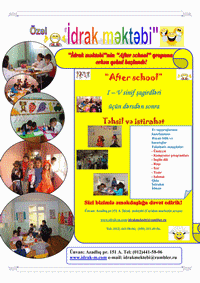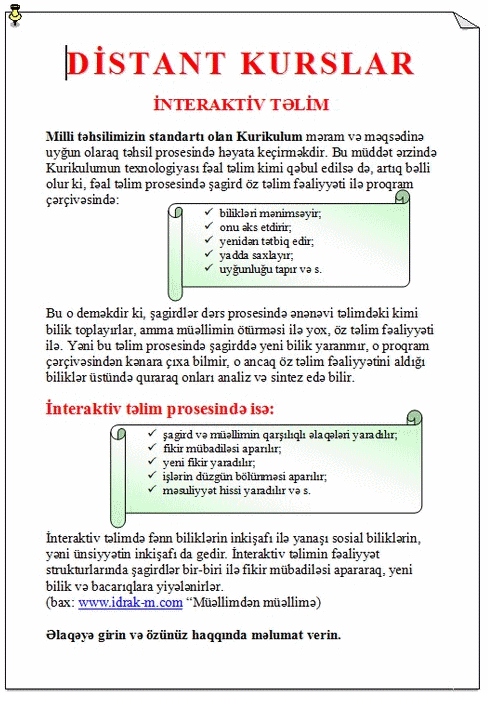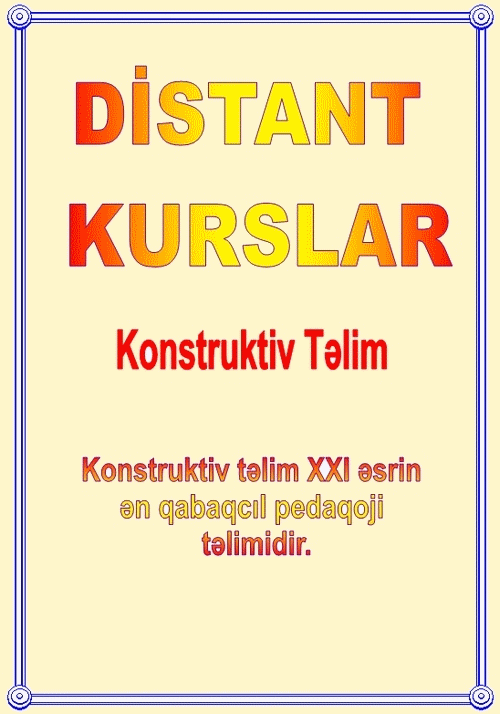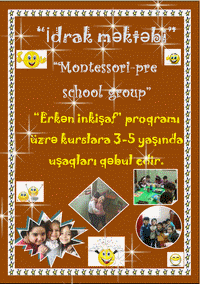ICRES 2017: International Conference on Research in Education and Science TRANSITION FROM TRADITIONAL LESSON TO CONSTRUCTIVE LESSON, IE. TRANSITION FROM TEACHING TO LEARNING
Nazim Gardashov
Deputy Director
High school 149 Xazar distrasct Baku
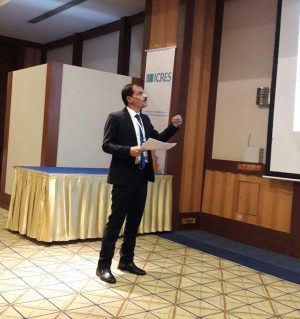 Abstract: At the beginning of the 21st century, educational system in Azerbaijan was reconstructed and
Abstract: At the beginning of the 21st century, educational system in Azerbaijan was reconstructed and
modernized. The usage of innovative teaching technologies, ICT and pedagogical technologies, the application
of active, project, problem and constructive teaching are considered one of the essential issues. New pedagogical
studies should be carried out in order to solve these problems and to find out their being effective. In the
traditional way of teaching which was applied for centuries, the teacher was required to transfer knowledge and
the students were required to remember and apply their knowledge properly.The traditional way of teaching was
based on pragmatism — one of trends of the education philosophy ie. the teacher was in the center of the
teaching process, the pupils were acquiring knowledge passively, teacher-student relations were like subjectobject.
Therefore, it is right to abandon traditional way of teaching completely because it is a teaching theory and in this
teaching process which is based on theory mental skills of cognition such as knowledge, comprehension, and
application are improved. If we want to train a high-thinking personality according to the requirements of the
technological community, we must build up the training process on the principles teaching theory together with
the principles of learning theory.Together with memory, application, comprehension, we must improve the
highest level of thinking: That is, we have to put into practice the analysis, creation and evaluation mechanisms
which are considered the highest levels of cognition. When we attach much importance to the mental acttivities
such as analysis, creation, and evaluation in addition to the knowledge at the lesson, the traditional lesson is
transformed into an innovative – constructive lesson
Keywords: Constructive learning, pragmatism, creation, evaluation, Blooom’s taxonomy, theory of learning,
teaching theory.
Introduction
At the beginning of the 21st century, educational system in Azerbaijan was reconstructed and modernized. The
usage of innovative teaching technologies, ICT and pedagogical technologies, the application of active, project,
problem and constructive teaching are considered one of the essential issues. New pedagogical studies should be
carried out in order to solve these problems and to find out their being effective.
In the traditional way of teaching which was applied for centuries, the teacher was required to transfer
knowledge and the students were required to remember and apply their knowledge properly.The traditional way
of teaching was based on pragmatism — one of trends of the education philosophy ie. the teacher was in the
center of the teaching process, the pupils were acquiring knowledge passively, teacher-student relations were
like subject-object. Alongside its disadvantages, the traditional way of teaching had a number of advantages also.
In this way of teaching, much scientific information is provided within a short period of time, difficultly
comprehended knowledge is explained to the students in detail (minutely), time is saved and pedagogical
processes are managed effectively. Therefore, it is right to abandon traditional way of teaching completely
because it is a teaching theory and in this teaching process which is based on theory mental skills of cognition
such as knowledge, comprehension, and application are improved. The results of the teaching theory are placed
at the lowest level of Bloom’s cognitive taxonomy.
International Conference on Research in Education and Science (ICRES), May 18 — 21, 2017 Ephesus-Kusadasi/Turkey
204
If we want to train a high-thinking personality according to the requirements of the technological community,
we must build up the training process on the principles teaching theory together with the principles of learning
theory.Together with memory, application, comprehension, we must improve the highest level of thinking: That
is, we have to put into practice the analysis, creation and evaluation mechanisms which are considered the
highest levels of cognition. When we attach much importance to the mental acttivities such as analysis, creation,
and evaluation in addition to the knowledge at the lesson, the traditional lesson is transformed into an innovative
– constructive lesson.
Constructivism being one of the pedagogical — philosophical trends is a theory of learning (J. Piaget) and while
delivering a lesson with the help of constructive teaching based on this theory (F. Bunyatova), pupils are given
the opportunity of creating new knowledge based on their acquired knowledge. The principles of three
philosophical trends — pragmatism, progressiveism and constructivism are used. In pragmatism, ways of
teaching, methodological approaches; in progressiveism, pupils’ engagement; and in constructivism, pupils’
thought and intellectual activity is emphasized. It proes that each knowledge should be understood,
consolidated(praqmatism) by the pupil, knowledge should be discussed within the team and at classes (the signs
of progressivism), and mental actions should be cariied out to build up new personal knowledge
(constructivism).
In this case, teaching (pragmatism) is transformed into comprehension (cognitivism), cognition is transformed
into creativity (constructivism), and adds a new level – creativity- to the levels of J.Bloom’s cognitive taxonomy
(knowledge, comprehension, analysis, evaluation).
Methods
On the example of a constructive lesson we want to show the process of creating new knowledge. 3rd class
Azerbaijani language lesson: a fragment from a constructive lesson. The teacher clarifies in advance the logical
relationship between the students’ knowledge, and determines to which conclusion they will come by
completing this relations with other relations, attitutedes, similarities, and how they will elucidate their own
acquired knowledge. It was evening. The children returned to the village.
Q: What kind of are sentences they?
A: Simple sentences
Q; Can we combine these sentences?
A: Yes, we can combine.
A: No, they can’t be combined.
The answers are different.
T: When we combine two words, we have a compound word. The sentence consists of words. If the words are
combined and a compound word is formed, then can sentences combine to form a sentence?
The answers are discussed and they decide that they can be combined.
T: If we combine, what kind of sentences will they be?
A: One sentence with two sentences.
Here is the supplementary information by the teacher:
There are two simple sentences in this sentence. Such sentences are called composite sentences. Composite
means that the sentence is composed of several parts. This supplementary information by the teacher creates a
complete scheme of their present knowledge with their future knowledge (knowledge from the 5th class).
The teacher asks logically sequenced by going into the theme’s sturcture and makes students think while
switching from one structure to another. The questions are problematic in order to think over and come to the
conclusion. In this fragment, we saw the relationship between acquired knowledge and future knowledge.
Another example. Beginning from the ontogenesis of knowledge about equation till the finding process of the
sum are discussed in order to assume the rule. Then multiplicative and substitution operations of constructive
teaching are used. In order to apply this rule in another field, pupils are given the following logical task: (primary
school, 4th grade)
Generelizing and logically reasoning of the teacher’s discussion. Thus, to solve the equation 6 ∙ x = 24, we
divide the sum 24 into multiplier 6 and we had 4 in solution. Then what kind of equation will we have if we
replace the multiplier 6 in this equation by the letter a and the sum 24 by letter b?
A: the equation
Q: How do we solve this equation?
International Conference on Research in Education and Science (ICRES), May 18 — 21, 2017 Ephesus-Kusadasi/Turkey
205
A:
Q: What steps did we take to transform the equation into and to solve it?
A: 1) first in order to find ,
2) we substituted the numbers for letters and we had got equation ; as we substituted numbers, we
applied the same rules to the letters we did the numbers. And so we got .
The pupils created new knowledge based on the given questions, the students were able to draw a new algebraic
expression from their knowledge about equation. Afterwards, their acquired knowledge is consolidated. To
achieve this goal, to consolidate their knowledge, they are asked to apply this knowledge to the tasks.
1) 10 x = 50; 2) 28 : x = 14
3) x = ; 4 ) x : =
5) = ; 6) : =
The first and second assignments are directed to the consolidating of knowledge. The third and fourth tasks are
directed to comprehension and help to discover pupils’ mathematical abilities. The fifth and sixth tasks are
creative, and the pupils themselves build up examples.
Recommendations
The main purpose of the national curriculum applied in Azerbaijan is to acquire knowledge. Acquiring itself
means to reflect the given knowledge. As a result of the research carried out at the lesson, there is a great gap
between the acquired knowledge and its understanding and emerging. The main reason for this gap is that the
tasks given in the textbooks are inclined to reflect and apply knowledge.
The lack of creation of knowledge means that the students do not possess these mental abilities. If the
assignments about these questions are included in the textbook, if the teacher has a mechanism to create them in
the classroom, and if they are applied at the classes, then the quality of the teching will significantly increase,
and the growing generation will not only acquire knowledge, but also they will be creative persons.
Thus, the transition from teaching to learning is a way from pragmatism to a constructive way of thinking, and in
the result the teacher’s thoughts and the student’s thoughts will also logically improve.
References
Bunyatova (2007) F.J Konstruktiv təlim: təyini, mahiyyəti.və dərslərdən nümünələr
R.İsmaylov , Solmaz Abdullayeva (2015) Azervaycan dili -3 Dərslik
R.İsmaylov , Solmaz Abdullayeva (2015) Azervaycan dili -3 Metodik vəsait
Naime Gahramanova .(2015) Riyaziyyat- 3 Dərslik
http://www.idrak-m.com/?p=4678 İnteraktiv yanaşma ilə konstruktiv təlimlə aparılan dərs modeli
http://portal.edu.az/index.php?r=article/blog&id=6&mid=5&lang=az




